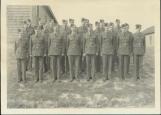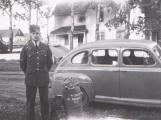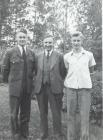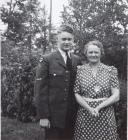1
WWII Veteran, Rod French2
In the spring of 1943, war still raged in Europe, Asia and the Pacific. Young men reaching the age of eighteen years were still being conscripted into the services.I had received a letter after my birthday in April ordering me to report to the nearest Enlistment Centre. My dad was able to get a deferment until I wrote my final exams and finished high school.
I thought a lot about which service to join. I had been with the Wetaskiwin #42 Air Cadet Squadron for a year. Dad was a lieutenant in the Royal Flying Corps in the First World War and was sent overseas. I decided I would like to do the same.
4
A week after school was over, two of my school chums and I reported to the Edmonton Enlistment Depot. We signed up for the R.C.A.F. and had our first medical. The screening tests indicated that I had a colour vision problem. I didn't believe them; however, further testing confirmed it and I was classified "colour vision deficient - unsafe." This was disappointing news as it prevented me from getting into aircrew.6
I was issued a train ticket and was posted to #1 Manning Depot in Toronto located at the Toronto Exhibition grounds. We were housed in a large building known as the "Bull Pen." It contained dividers or stalls which once separated the cattle during the Exhibition. During training, each stall contained two double-decker bunk beds making room for about one thousand men.We were issued uniforms and started basic training - regular exercise drills like learning to march properly and take commands. While at #1 Manning Depot, further aptitude tests were taken to determine what I could go into. Electrical technician was a possible choice but all wiring was colour coded, so that was out. I then tried for armament (the bombs had colour coded fuses but by that time, I had almost memorized the colour vision tests) and they passed me for training as a bomb armourer.
I stayed at Manning Depot for a couple of months and when I had a weekend pass, I would visit various parts of Ontario, like Niagara Falls.
7
I was soon posted to Mountain View, Ontario near Belleville to take my training as a bomb armourer. I graduated after six months and was posted to Edmonton, Alberta #2 Air Observer School (AOS). It was there that the air crew learned navigation and also did some practice bombing using Anson MK5 aircraft. Some of our duties in the armament section were to maintain the bomb racks attached to the aircraft and load them with ten pounds practice bombs and magnesium flares when there was night training.8
Some of us were transferred to Winnipeg for two weeks of temporary duty for similar work. After returning to Edmonton #2 AOS, I was posted to #10 Repair Depot Calgary for about a month of temporary duty. The work there was to clean, repair and refinish the bomb racks which had become corroded during use.After returning back to Edmonton, life became pretty routine. Two others and I wondered if a request for posting overseas would be successful. We spoke to the adjutant and he agreed to forward our request to RCAF Headquarters. Our timing couldn't have been better. Unbeknown to us, the RCAF was starting to form two Canadian Transport squadrons and they required men for the armament section.
We went by train to Halifax and then on to Debert, N.S. to receive a series of inoculations. Some of them were for yellow-fever and cholera, which made us suspect that we would be going to South East Asia rather than Europe. (It turned out that the two Canadian Transport squadrons, 435 and 436, would be sent to India and Burma to fly supplies to the allied troops fighting the Japanese).
During our time between Halifax and Debert, we were able to hitch-hike through the Annapolis Valley which was very beautiful and had many orchards.
11
With our inoculations over, we returned to Halifax and received two weeks embarkation leave. I spent time at home and then returned to Halifax on August 20, 1944.14
Upon arriving in Halifax, I boarded the passenger liner the "Aquatania." It had been fitted out as a troop ship with bunks and hammocks for sleeping. We were the advance party. I was assigned to help serve food in the galley (which had lots of cockroaches). Some English chaps who had been training in Canada did not like the way we served the food so they took over our duties. We didn't mind a bit. The journey took about five days and the seas were a little rough. The ship was quite fast and was able to travel without an escort; however, a day or so before docking there was a submarine scare and we did a lot of zigzagging. We arrived safely at Gorrik, Scotland and admired the lovely green hills.After disembarking, we boarded a train for the long journey to Bournemouth on the south coast of England. This was basically a holding area where we were issued lightweight tropical clothes and rain ponchos.
A few weeks later, we went to a place near Liverpool to wait for the next part of our journey. As DC3 aircraft became available, we started to move out. I left on Friday, October 13 on aircraft # 613. The first stop was Gibraltar. The next day we flew to Tripoli to overnight, then on across North Africa to Cairo. The next morning we went to Basra, Iraq and finally on to Karachi, India. It was a transit station as most personnel arriving by air went there to become acclimatized to the change in temperature, water, and food. Most people, myself included, had diarrhea ("squitters" we called it), which was treated with caster oil and then "cement."





